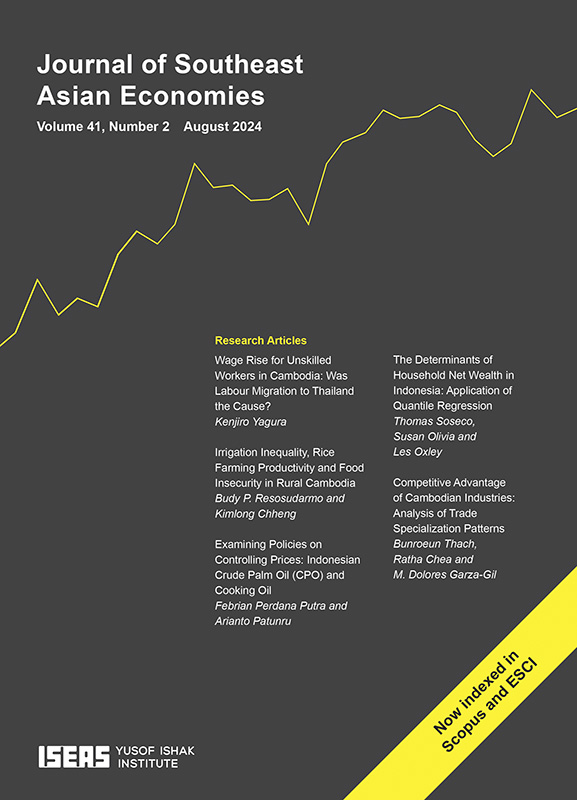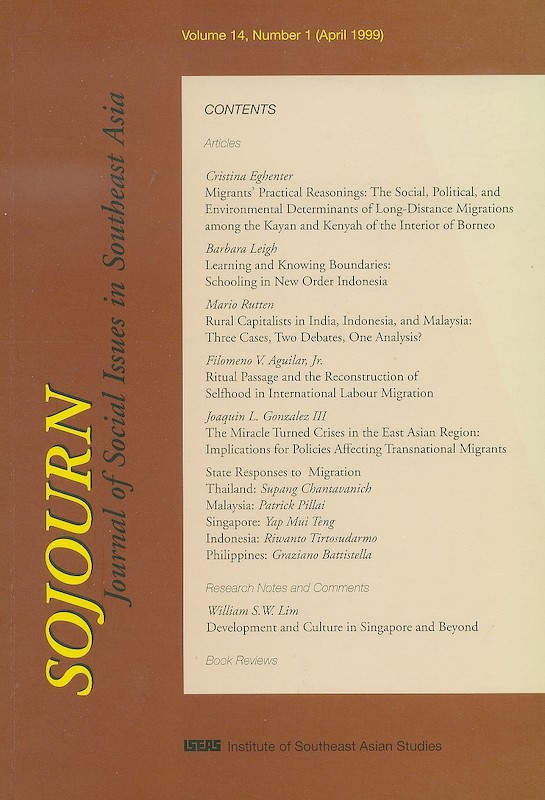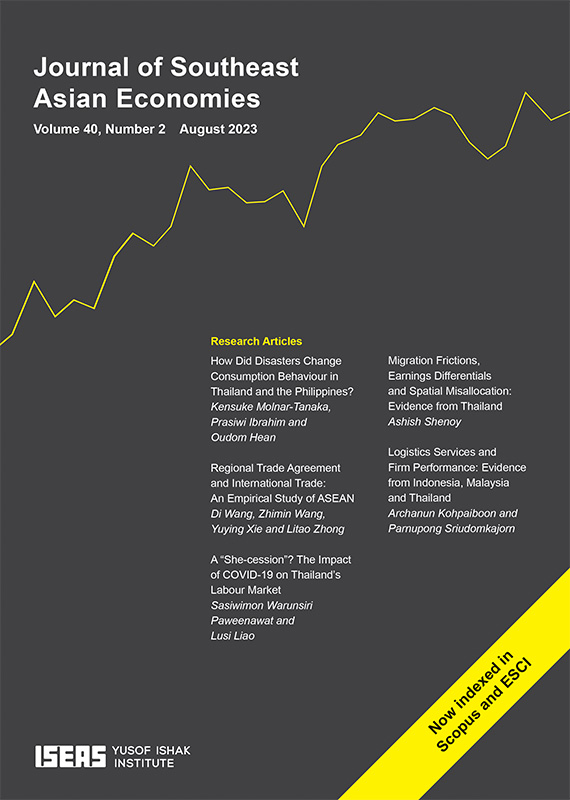ASEAN Economic Bulletin Vol. 12/2 (Nov 1995). Special Focus on "Labour Migration in Asia"

Date of publication:
November 1995
Publisher:
Institute of Southeast Asian Studies
Number of pages:
194
Code:
AE12/2
About the publication
Special Focus on "Labour Migration in Asia".
Contents
-
Preliminary pages
-
Overview, by Philip L Martin, Andrew Mason, Ching-lung Tsay, contributors
-
Asian Labour Migration: Past, Present, and Future, by Manolo I Abella, contributor see abstractWhile the growth of trade may have substituted for potential movements of labour, its overall impact has been to stimulate economic growth and employment, and social and demographic changes which in turn create shortages of labour. As the regional economy continues to expand at a rapid pace, pressures will increase for importing foreign labour to do jobs that national workers no longer want.
-
Japan, by Yoshio Okunishi, contributor see abstractIn 1993, the 950,000 foreign workers in Japan were about 1.5 per cent of the total workforce. They included 300,000 illegal unskilled workers, 160,000 descendants of Japanese who had migrated to South America (both groups which increased rapidly in the late 1980s and the early 1990s); 100,000 legal workers with work visas, who have increased steadily; and 320,000 Korean permanent-resident workers, who have lived in Japan for decades. In part due to an economic recession which began in 1992, the foreign workforce has stabilized in the mid-1990s. Sluggish economic growth and the transfer of business activities overseas may restrict the demand for foreign workers in Japan. However, persisting labour shortages in low-wage industries may maintain the demand for unskilled (and often illegal) foreign workers.
-
Korea, by Young-bum Park, contributor see abstractKorea, once a major labour-exporting country, is considering opening its labour market to foreign labour. Since the mid-1980s, unemployment rates have been around 2.5 per cent. With this tight labour market, some industries have found it hard to locate Korean workers, and immigrant workers have trickled into the country. There has not been a clear-cut government policy concerning foreign labour despite the existence of a substantial number of foreign workers. Instead, the foreign trainee system was introduced to ease labour shortages for small manufacturers. However, the trainee system is considered to be temporary since trainees are to return to their home countries after a maximum of two years. It is highly likely that more foreign workers will enter Korea. However, the Korean Government consistently argues that the current labour shortages can be lessened by utilizing domestic human resources more efficiently. This suggests that illegal rather than legal foreign worker numbers will rise while Korean policy makers discuss whether Korea needs unskilled foreign labour.
-
Taiwan, by Ching-lung Tsay, contributor see abstractTaiwanâs experience of using foreign workers began in the early 1980s when the island was facing increases in domestic real wages and sharp appreciation of the Taiwanese currency. This article analyses data on foreign workers in Taiwan during the period before and after the opening up of the labour market. It focuses on volume and characteristics of foreign workers, namely, source countries and the industry in which they are employed on the island. The results show some similarities between illegal entrants and contract foreign labourers on the source countries and, to some extent, type of industry in which they are employed. However, there seems to be a clear segregation in the Taiwanese labour market among foreign workers of different sources. Thai workers dominate the construction industry while the Filipinos occupy personal service jobs and manufacturing employment. The article also reviews and discusses government policies and programmes concerning the importation of foreign workers in Taiwan.
-
Immigration and Foreign Labour in Singapore, by Chew Soon Beng , Rosalind Chew, contributors see abstractThe overwhelming success of the Singapore Governmentâs industrialization strategy through foreign investment enabled the republic to progress rapidly from a situation of high unemployment to one of labour shortage. To retain its competitive edge, Singapore must continue to upgrade its workforce in skills and in work attitude. In addition, Singapore has adopted the policy of encouraging talented and skilled foreigners to settle there to help the economy achieve even better economic performance. This article examines Singaporeâs policy on immigration, with particular reference to foreign labour, and discusses the sociopolitical effects of a migrant labour force.
-
Labour Migration to Hong Kong, by Ronald Skeldon, contributor see abstractThis article examines two very different types of migration to Hong Kong: the movements from China and the movements of contract labour. These migrations are considered within the context of the structural change in the Hong Kong economy from an entrepôt, through its development into a major industrial centre, to the most recent phases of de-industrialization and Hong Kongâs emergence as a service economy. Migration from China was an essential component in this transformation although, since its restriction and control after October 1980, Hong Kong has turned more towards foreign sources of labour. Like global cities in other parts of the world, Hong Kong imports highly skilled expatriates from around the world, as well as low-paid labour from regional sources and from China.
-
Malaysia, by Patrick Pillai, contributor see abstractMalaysia reflects the complexity of international migration, being a labour receiver and sender. While foreign workers alleviate labour shortages, lower costs and help fuel growth, uncontrolled access to low-cost unskilled foreign labour can impede economic upgrading and pose political, security and social problems. Migration is likely to increase in the next decade, but the rate and pace of entry will hinge on the political will and institutional capacity of the state to link an effective immigration policy with restructuring goals. This article provides a broad overview of development strategies and their impact on the labour market, describes stocks and flows of mobile labour and their economic, political and social impact, and concludes by examining future trends.
-
Labour Market Adjustments and Migration in Thailand, by Chalongphob Sussangkarn, contributor see abstractThis study reviews Thailandâs past economic development trends and the effects on labour market adjustments and migration. The Thai economy has grown by over 7 per cent per annum on average over the past 35 years. Growth has been accompanied by major structural transformations, from agrarian-based, to industry and services. Migration patterns in Thailand reflect changes in the economy and the labour market. Internally, the main migration movements are towards Bangkok and the surrounding provinces, reflecting income gaps between urban and rural areas. Many low-skilled and semi-skilled Thai workers also work abroad, particularly in the Middle East and other higher income East Asian economies. Thailand also has a large number of foreign workers. One group consists of highly-skilled professionals who work in foreign investment related enterprises, as well as serve to fill gaps created by shortages of technical manpower. This group does not cause any major concern for Thailand. A second group consists of illegal migrant workers from Thailandâs poorer neighbouring countries. This group is a major concern to the government, and concrete policies are needed to effectively deal with illegal migrant workers.
-
Philippine Overseas Labour: From Export to Management, by Graziano Battistella, contributor see abstractAfter twenty years of labour export, the Philippine overseas labour programme is subject to renewed discussion, spurred by some events, like the execution of Flor Contemplacion and the trial of Sarah Balabagan. This article joins the discussion and highlights reasons why a decisive change in the management of migration is not to be expected. After reviewing the various phases of the programme, the article argues that three issues remain of crucial importance: the irregular migration of Filipinos, generated also by practices of the recruiting industry; the protection of migrants in a region lacking specific agreements; the management of migration in a globalizing economy. The article concludes with a discussion on the bill recently adopted in the Philippines which mandates for a lesser role of the government in the regulation of the migration process.
-
Labour Export from Indonesia: An Overview, by Graeme Hugo, contributor see abstractIndonesia has become one of the most significant labour exporting nations in the Asian region. Accordingly, labour export has assumed greater importance in government economic planning, and has also become a topic of increasing interest among the wider community. This article addresses some of the important issues which have attracted most attention in recent years and provides an overview of the contemporary situation in Indonesia with respect to international labour migration. Important issues in Indonesia relating to the export of labour include the high level of illegal movement, predominantly to Malaysia; the large deployment of women to work as domestic maids in Saudi Arabia, Singapore, Hong Kong and elsewhere; the role of recruiters and other intermediaries in the export of labour, and the skill profile of workers going abroad.
-
Labour Migration of China, by Yunhua Liu, contributor see abstractAccompanying the open door policy and economic reform, a dynamic population movement in China is occurring. International population movement of China is characterized mainly by the phenomenon of âbrain drainâ and illegal emigrants. Two-thirds of the overseas Chinese students stayed overseas, resulting in a severe shortage of middle aged professors and researchers in China. Illegal Chinese emigration into North America and Europe in recent years was considerable. Internal labour migration in China now is a big social and economic issue, numbering up to 60 million. Although instability accompanies mass internal migration, the possibility of turmoil or riots is very low. Further rural reform in China, therefore, is called for to solve the surplus labour problem.






